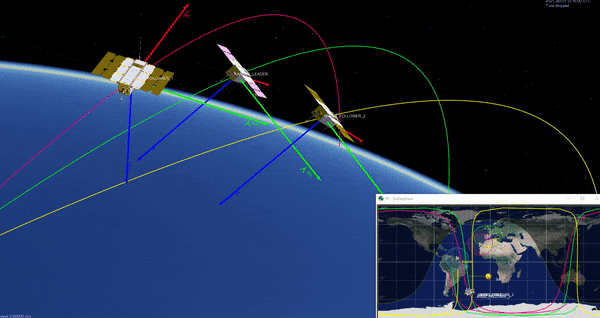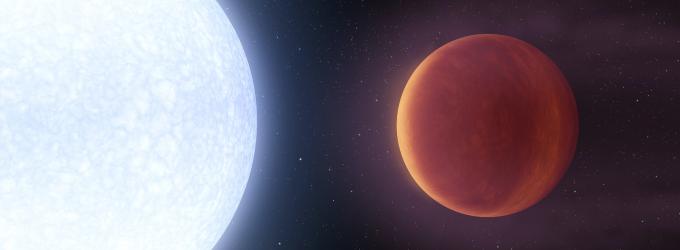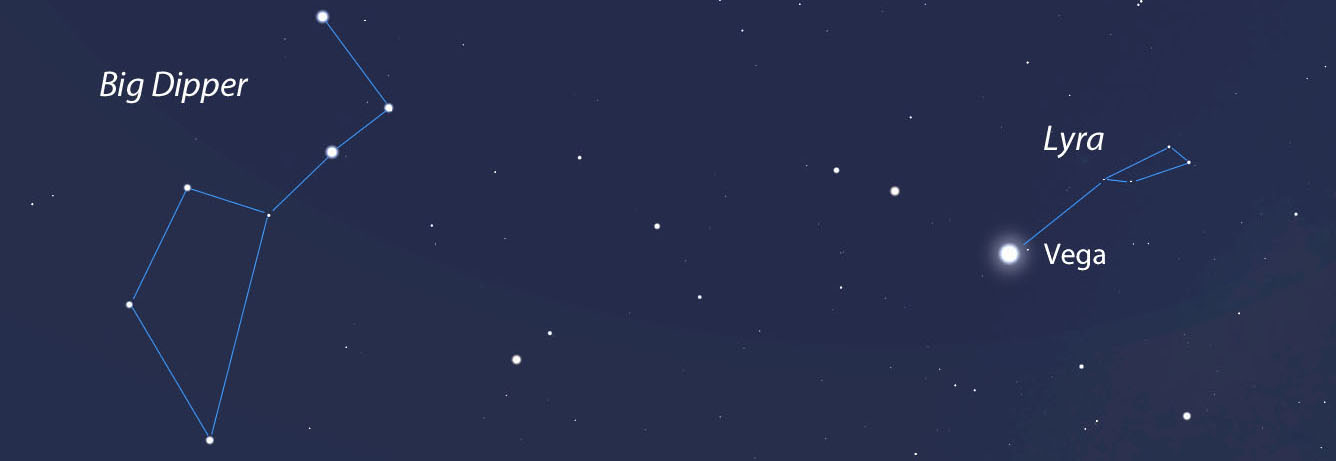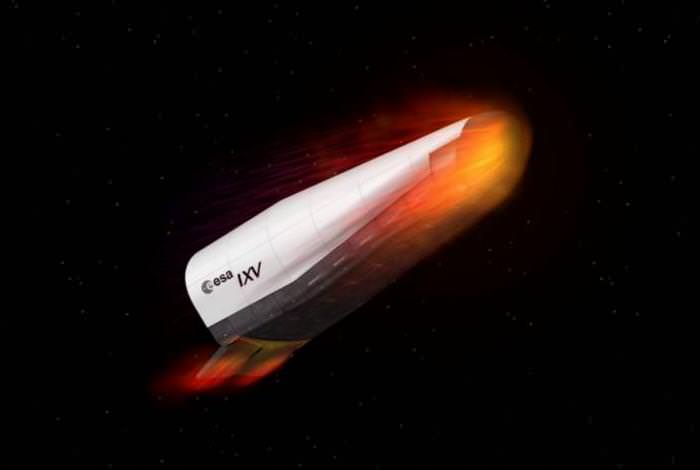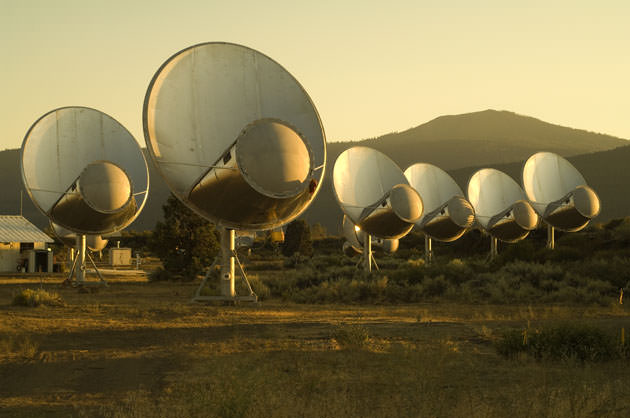CubeSats are taking on more and more responsibility for remote monitoring of the Earth. As they become more ubiquitous, they will also gain more varied propulsion systems. Or, in the case of a new set of monitoring CubeSats from INTA, Spain’s Institue of Aerospace Technology, no propulsion system at all.
Continue reading “A Flock of CubeSats Will Use Wings to Maneuver at the Edge of Space”A Private Mission to Scan the Cloud Tops of Venus for Evidence of Life
The search for life on Venus has a fascinating history. Carl Sagan famously and sarcastically said there were obviously dinosaurs there since a thick haze we couldn’t see through covered the surface. More recently, evidence has pointed to a more nuanced idea of how life might exist on our sister planet. A recent announcement of phosphine in the Venusian atmosphere caused quite a stir in the research community and numerous denials from other research groups. But science moves on, and now some of the researchers involved in the phosphine finding have come up with a series of small missions that will help settle the question more thoroughly – by directly sampling Venus’ atmosphere for the first time in almost 40 years.
Continue reading “A Private Mission to Scan the Cloud Tops of Venus for Evidence of Life”Vega Might Have a Planet
Vega is one of the brightest and best known stars in the night (or even twilight) sky. Located in the constellation Lyra, it is only 25 light years from Earth, and about twice our Sun’s mass. And now, astronomers might have found one of the hottest known planets orbiting it extraordinarily quickly.
Continue reading “Vega Might Have a Planet”A Balloon Mission that Could Try to Confirm Life On Venus
So, Venus might have life! But how do we find out for sure?! We need to GO there.
Continue reading “A Balloon Mission that Could Try to Confirm Life On Venus”Astronomers are Tracking the Interstellar Asteroid ‘Oumuamua to its Home System

On October 19th, 2017, the Panoramic Survey Telescope and Rapid Response System-1 (Pan-STARRS-1) in Hawaii announced the first-ever detection of an interstellar asteroid – I/2017 U1 (aka. ‘Oumuamua). Since that time, multiple studies have been conducted to determine the asteroid’s origin, what it encountered in interstellar space, its true nature (is it a comet or an asteroid?), and whether or not it is an alien spacecraft (it’s not).
In all this time, the question of ‘Oumuamua’s origin has remained unanswered. Beyond theorizing that it came from the direction of the Lyra Constellation, possibly from the Vega system, there have been no definitive answers. Luckily, an international team led by researchers from the Max Planck Institute for Astronomy (MPIA) have tracked ‘Oumuamua and narrowed down its point of origin to four possible star systems.
Continue reading “Astronomers are Tracking the Interstellar Asteroid ‘Oumuamua to its Home System”
The Big Dipper in the Year 92,000

You go out and look at the stars year after year and never see any of them get up and walk away from their constellations. Take a time machine back to the days of Plato and Socrates and only careful viewing would reveal that just three of the sky’s naked eye stars had budged: Arcturus, Sirius and Aldebaran. And then only a little. Their motion was discovered by Edmund Halley in 1718 when he compared the stars’ positions then to their positions noted by the ancient Greek astronomers. In all three cases, the stars had moved “above a half a degree more Southerly at this time than the Antients reckoned them.”
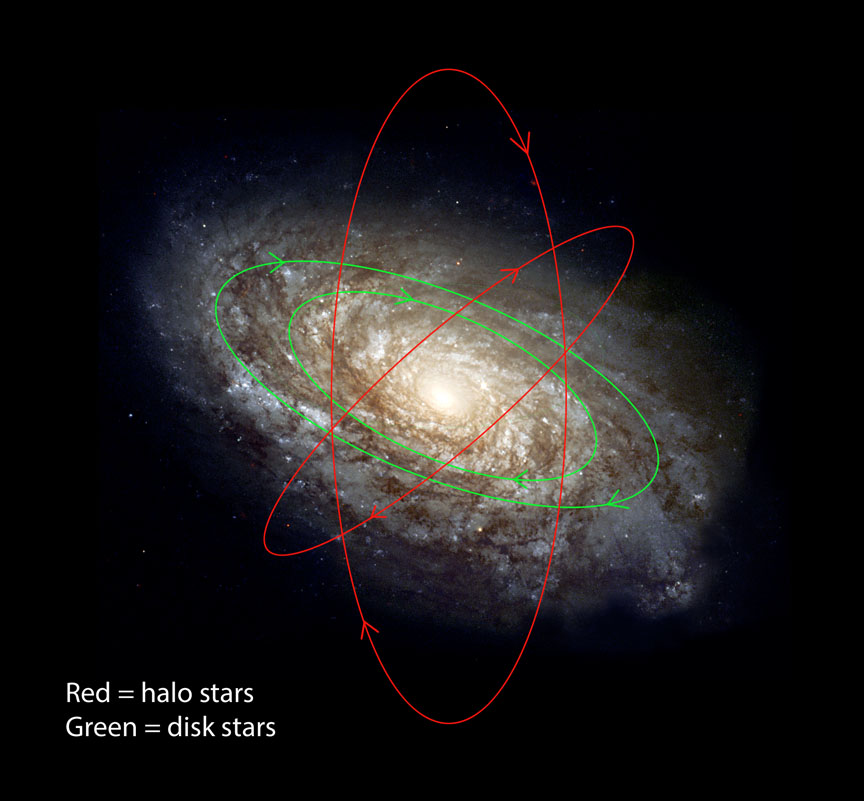
Stars are incredibly far away. I could throw light years around like I often do here, but the fact is, you can get a real feel for their distance by noting that during your lifetime, none will appear to move individually. The gems of the night and our sun alike revolve around the center of the galaxy. At our solar system’s distance from the center — 26,000 light years or about halfway from center to edge — it takes the sun about 225 million years to make one revolution around the Milky Way.
That’s a LONG time. The other stars we see on a September night take a similar length of time to orbit. Now divide the average lifetime of some 85 years into that number, and you’ll discover that an average star moves something like .00000038% of its orbit around the galactic center every generation. Phew, that ain’t much! No wonder most stars don’t budge in our lifetime.
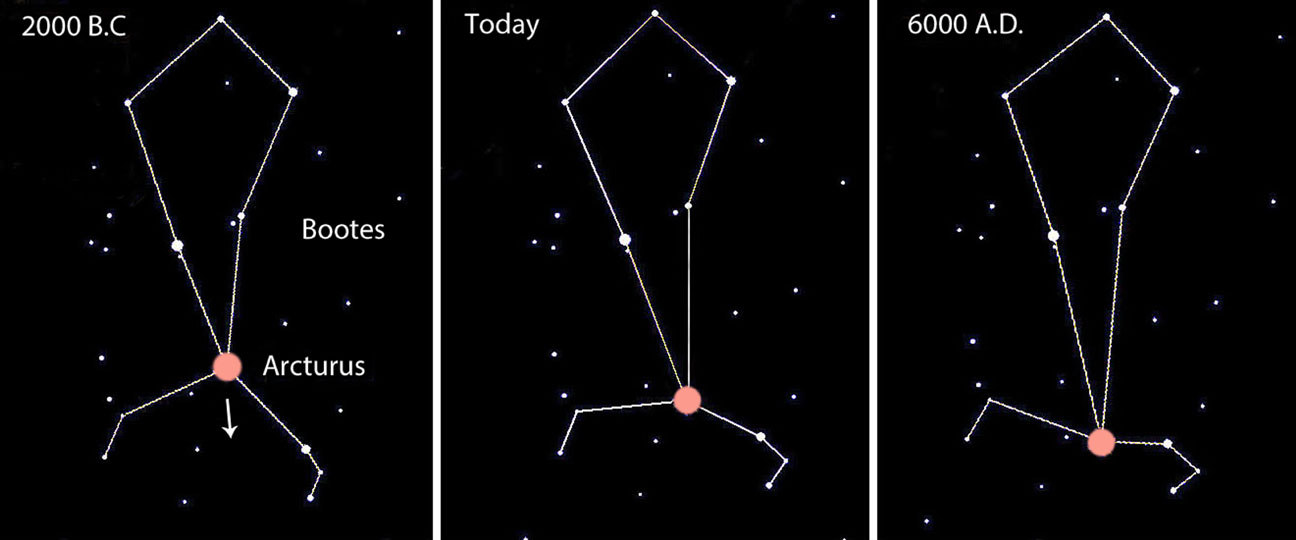
Sirius, Aldebaran and Arcturus and several other telescopic stars are close enough that their motion across the sky becomes apparent within the span of recorded history. More powerful telescopes, which expand the scale of the sky, can see a great many stars amble within a human lifetime. Sadly, our eyes alone only work at low power!
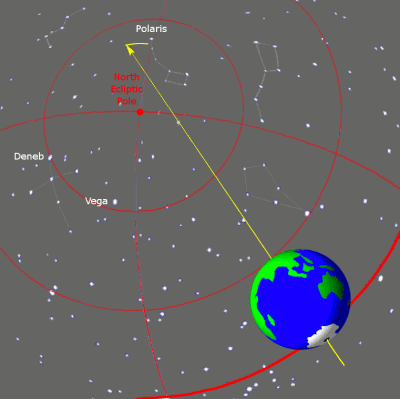
But we needn’t invest billions in building a time machine to zing to the future or past to see how the constellation outlines become distorted by the individual motions of the stars that compose them. We already have one! Just fire up a free sky charting software program like Stellarium and advance the clock. Like most such programs, it defaults to the present, but let’s look ahead. Far ahead.
If we advance 90,000 years into the future, many of the constellations would be unrecognizable. Not only that, but more locally, the precession of Earth’s axis causes the polestar to shift. In 2016, Polaris in the Little Dipper stands at the northernmost point in the sky, but in 90,000 years the brilliant star Vega will occupy the spot. Tugs from the sun and moon on Earth’s equatorial bulge cause its axis to gyrate in a circle over a period of about 26,000 years. Wherever the axis points defines the polestar.

Take a look at the Big Dipper. Wow! It’s totally bent out of shape yet still recognizable. The Pointer Stars no longer quite point to Polaris, but with some fudging we might make it work. Vega stands near the pole, and being much closer to us than the rest of Lyra’s stars, has moved considerably farther north, stretching the outline of the constellation as if taffy.

Time goes on. We look up at the night sky in the present moment, but so much came before us and much will come after. Constellations were unrecognizable in the past and will be again in the future. In a fascinating discussion with Michael Kauper of the Minnesota Astronomical Society at a recent star party, he described the amount of space in and between galaxies as so enormous that “we’re almost not here” in comparison. I would add that time is so vast we’re likewise almost not present. Make the most of the moment.
What Are The Most Famous Stars?

While there are untold billions of celestial objects visible in the nighttime sky, some of them are better known than others. Most of these are stars that are visible to the naked eye and very bright compared to other stellar objects. For this reason, most of them have a long history of being observed and studied by human beings, and most likely occupy an important place in ancient folklore.
So without further ado, here is a sampling of some of the better-known stars in that are visible in the nighttime sky:
Polaris:
Also known as the North Star (as well as the Pole Star, Lodestar, and sometimes Guiding Star), Polaris is the 45th brightest star in the night sky. It is very close to the north celestial pole, which is why it has been used as a navigational tool in the northern hemisphere for centuries. Scientifically speaking, this star is known as Alpha Ursae Minoris because it is the alpha star in the constellation Ursa Minor (the Little Bear).
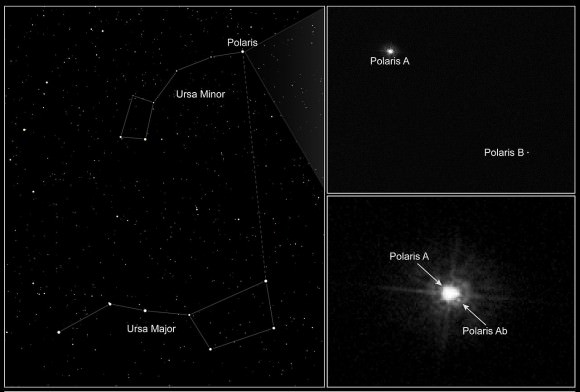
It’s more than 430 light-years away from Earth, but its luminosity (being a white supergiant) makes it highly visible to us here on Earth. What’s more, rather than being a single supergiant, Polaris is actually a trinary star system, comprised of a main star (alpha UMi Aa) and two smaller companions (alpha UMi B, alpha UMi Ab). These, along with its two distant components (alpha UMi C, alpha UMi D), make it a multistar system.
Interestingly enough, Polaris wasn’t always the north star. That’s because Earth’s axis wobbles over thousands of years and points in different directions. But until such time as Earth’s axis moves farther away from the “Polestar”, it remains our guide.
Because it is what is known as a Cepheid variable star – i.e. a star that pulsates radially, varying in both temperature and diameter to produce brightness changes – it’s distance to our Sun has been the subject of revision. Many scientific papers suggest that it may be up to 30% closer to our Solar System than previously expected – putting it in the vicinity of 238 light years away.
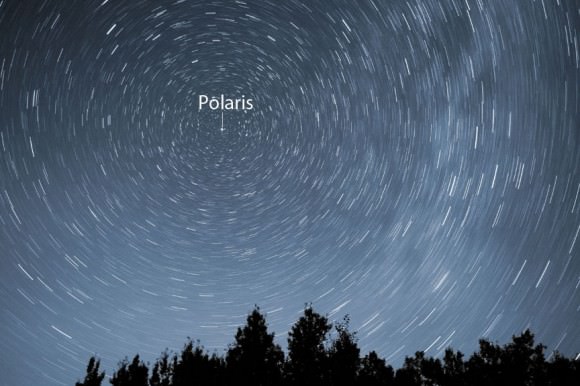
Sirius:
Also known as the Dog Star, because it’s the brightest star in Canis Major (the “Big Dog”), Sirius is also the brightest star in the night sky. The name “Sirius” is derived from the Ancient Greek “Seirios“, which translates to “glowing” or “scorcher”. Whereas it appears to be a single bright star to the naked eye, Sirius is actually a binary star system, consisting of a white main-sequence star named Sirius A, and a faint white dwarf companion named Sirius B.
The reason why it is so bright in the sky is due to a combination of its luminosity and distance – at 6.8 light years, it is one of Earth’s nearest neighbors. And in truth, it is actually getting closer. For the next 60,000 years or so, astronomers expect that it will continue to approach our Solar System; at which point, it will begin to recede again.
In ancient Egypt, it was seen as a signal that the flooding of the Nile was close at hand. For the Greeks, the rising of Sirius in the night sky was a sign of the”dog days of summer”. To the Polynesians in the southern hemisphere, it marked the approach of winter and was an important star for navigation around the Pacific Ocean.
Alpha Centauri System:
Also known as Rigel Kent or Toliman, Alpha Centauri is the brightest star in the southern constellation of Centaurus and the third brightest star in the night sky. It is also the closest star system to Earth, at just a shade over four light-years. But much like Sirius and Polaris, it is actually a multistar system, consisting of Alpha Centauri A, B, and Proxima Centauri (aka. Centauri C).
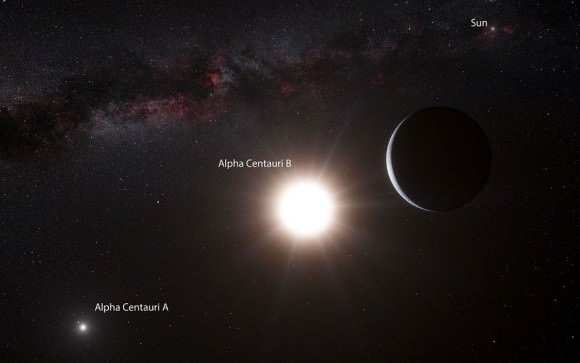
Based on their spectral classifications, Alpha Centauri A is a main sequence white dwarf with roughly 110% of the mass and 151.9% the luminosity of our Sun. Alpha Centauri B is an orange subgiant with 90.7% of the Sun’s mass and 44.5% of its luminosity. Proxima Centauri, the smallest of the three, is a red dwarf roughly 0.12 times the mass of our Sun, and which is the closest of the three to our Solar System.
English explorer Robert Hues was the first European to make a recorded mention of Alpha Centauri, which he did in his 1592 work Tractatus de Globis. In 1689, Jesuit priest and astronomer Jean Richaud confirmed the existence of a second star in the system. Proxima Centauri was discovered in 1915 by Scottish astronomer Robert Innes, Director of the Union Observatory in Johannesburg, South Africa.
In 2012, astronomers discovered an Earth-sized planet around Alpha Centauri B. Known as Alpha Centauri Bb, it’s close proximity to its parent star likely means that it is too hot to support life.
Betelgeuse:
Pronounced “Beetle-juice” (yes, the same as the 1988 Tim Burton movie), this bright red supergiant is roughly 65o light-year from Earth. Also known as Alpha Orionis, it is nevertheless easy to spot in the Orion constellation since it is one of the largest and most luminous stars in the night sky.
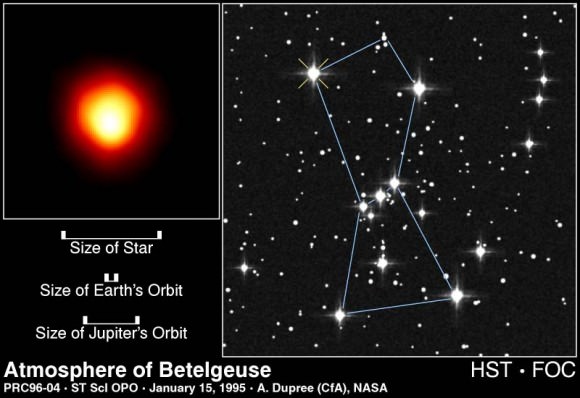
The star’s name is derived from the Arabic name Ibt al-Jauza’, which literally means “the hand of Orion”. In 1985, Margarita Karovska and colleagues from the Harvard–Smithsonian Center for Astrophysics, announced the discovery of two close companions orbiting Betelgeuse. While this remains unconfirmed, the existence of possible companions remains an intriguing possibility.
What excites astronomers about Betelgeuse is it will one day go supernova, which is sure to be a spectacular event that people on Earth will be able to see. However, the exact date of when that might happen remains unknown.
Rigel:
Also known as Beta Orionis, and located between 700 and 900 light years away, Rigel is the brightest star in the constellation Orion and the seventh brightest star in the night sky. Here too, what appears to be a blue supergiant is actually a multistar system. The primary star (Rigel A) is a blue-white supergiant that is 21 times more massive than our sun, and shines with approximately 120,000 times the luminosity.
Rigel B is itself a binary system, consisting of two main sequence blue-white subdwarf stars. Rigel B is the more massive of the pair, weighing in at 2.5 Solar masses versus Rigel C’s 1.9. Rigel has been recognized as being a binary since at least 1831 when German astronomer F.G.W. Struve first measured it. A fourth star in the system has been proposed, but it is generally considered that this is a misinterpretation of the main star’s variability.
Rigel A is a young star, being only 10 million years old. And given its size, it is expected to go supernova when it reaches the end of its life.
Vega:
Vega is another bright blue star that anchors the otherwise faint Lyra constellation (the Harp). Along with Deneb (from Cygnus) and Altair (from Aquila), it is a part of the Summer Triangle in the Northern hemisphere. It is also the brightest star in the constellation Lyra, the fifth brightest star in the night sky and the second brightest star in the northern celestial hemisphere (after Arcturus).
Characterized as a white dwarf star, Vega is roughly 2.1 times as massive as our Sun. Together with Arcturus and Sirius, it is one of the most luminous stars in the Sun’s neighborhood. It is a relatively close star at only 25 light-years from Earth.
Vega was the first star other than the Sun to be photographed and the first to have its spectrum recorded. It was also one of the first stars whose distance was estimated through parallax measurements, and has served as the baseline for calibrating the photometric brightness scale. Vega’s extensive history of study has led it to be termed “arguably the next most important star in the sky after the Sun.”
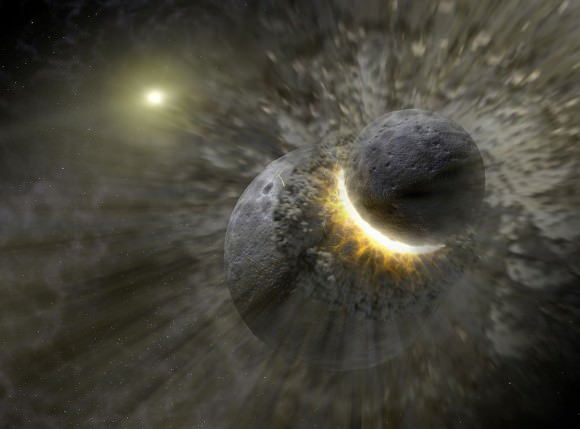
Based on observations that showed excess emission of infrared radiation, Vega is believed to have a circumstellar disk of dust. This dust is likely to be the result of collisions between objects in an orbiting debris disk. For this reason, stars that display an infrared excess because of circumstellar dust are termed “Vega-like stars”.
Thousands of years ago, (ca. 12,000 BCE) Vega was used as the North Star is today, and will be so again around the year 13,727 CE.
Pleiades:
Also known as the “Seven Sisters”, Messier 45 or M45, Pleiades is actually an open star cluster located in the constellation of Taurus. At an average distance of 444 light years from our Sun, it is one of the nearest star clusters to Earth, and the most visible to the naked eye. Though the seven largest stars are the most apparent, the cluster actually consists of over 1,000 confirmed members (along with several unconfirmed binaries).
The core radius of the cluster is about 8 light years across, while it measures some 43 light years at the outer edges. It is dominated by young, hot blue stars, though brown dwarfs – which are just a fraction of the Sun’s mass – are believed to account for 25% of its member stars.
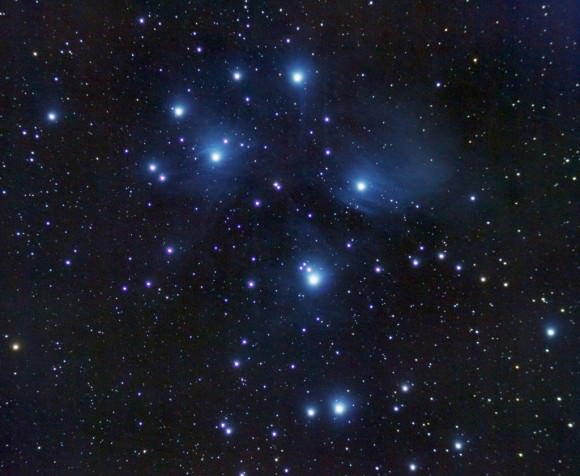
The age of the cluster has been estimated at between 75 and 150 million years, and it is slowly moving in the direction of the “feet” of what is currently the constellation of Orion. The cluster has had several meanings for many different cultures here on Earth, which include representations in Biblical, ancient Greek, Asian, and traditional Native American folklore.
Antares:
Also known as Alpha Scorpii, Antares is a red supergiant and one of the largest and most luminous observable stars in the nighttime sky. It’s name – which is Greek for “rival to Mars” (aka. Ares) – refers to its reddish appearance, which resembles Mars in some respects. It’s location is also close to the ecliptic, the imaginary band in the sky where the planets, Moon and Sun move.
This supergiant is estimated to be 17 times more massive, 850 times larger in terms of diameter, and 10,000 times more luminous than our Sun. Hence why it can be seen with the naked eye, despite being approximately 550 light-years from Earth. The most recent estimates place its age at 12 million years.
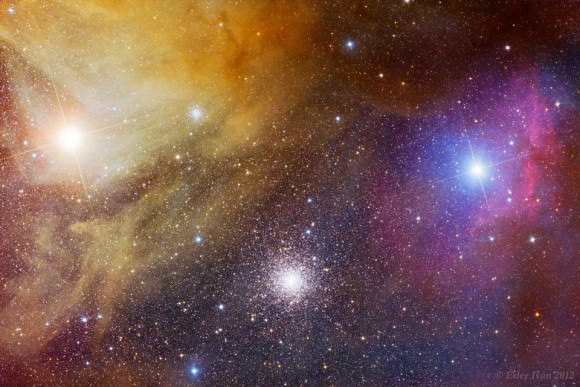
Antares is the seventeenth brightest star that can be seen with the naked eye and the brightest star in the constellation Scorpius. Along with Aldebaran, Regulus, and Fomalhaut, Antares comprises the group known as the ‘Royal stars of Persia’ – four stars that the ancient Persians (circa. 3000 BCE) believed guarded the four districts of the heavens.
Canopus:
Also known as Alpha Carinae, this white giant is the brightest star in the southern constellation of Carina and the second brightest star in the nighttime sky. Located over 300 light-years away from Earth, this star is named after the mythological Canopus, the navigator for king Menelaus of Sparta in The Iliad.
Thought it was not visible to the ancient Greeks and Romans, the star was known to the ancient Egyptians, as well as the Navajo, Chinese and ancient Indo-Aryan people. In Vedic literature, Canopus is associated with Agastya, a revered sage who is believed to have lived during the 6th or 7th century BCE. To the Chinese, Canopus was known as the “Star of the Old Man”, and was charted by astronomer Yi Xing in 724 CE.
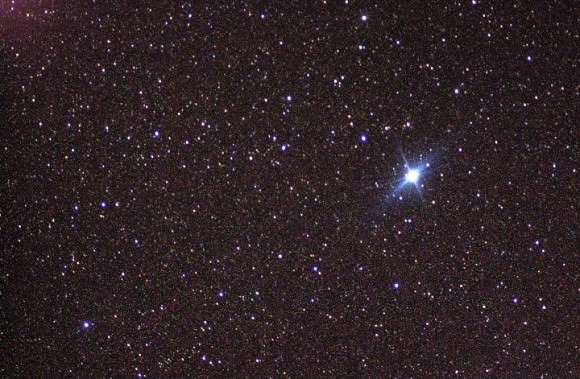
It is also referred to by its Arabic name Suhayl (Soheil in persian), which was given to it by Islamic scholars in the 7th Century CE. To the Bedouin people of the Negev and Sinai, it was also known as Suhayl, and used along with Polaris as the two principal stars for navigation at night.
It was not until 1592 that it was brought to the attention of European observers, once again by Robert Hues who recorded his observations of it alongside Achernar and Alpha Centauri in his Tractatus de Globis (1592).
As he noted of these three stars, “Now, therefore, there are but three Stars of the first magnitude that I could perceive in all those parts which are never seene here in England. The first of these is that bright Star in the sterne of Argo which they call Canobus. The second is in the end of Eridanus. The third is in the right foote of the Centaure.”
This star is commonly used for spacecraft to orient themselves in space, since it is so bright compared to the stars surrounding it.
Universe Today has articles on what is the North Star and types of stars. Here’s another article about the 10 brightest stars. Astronomy Cast has an episode on famous stars.
New Plans for ESA’s Experimental Re-entry Vehicle
[/caption]
ESA and Arianespace have signed a contract planning the launch of ESA’s new IXV (Intermediate eXperimental Vehicle) on Europe’s new Vega Rocket in 2014. Vega is Europe’s new small launch system and it is designed to complement the heavy Ariane 5 and medium Soyuz Rocket systems launched from French Guiana.
The small rocket is capable of a wide range of payloads up to 1.5 tonnes, compared to Ariane 5 which can lift 20 tonnes, making it especially suitable for the commercial space market. The Vega Rocket will launch the IXV into a suborbital trajectory from Europe’s Spaceport in French Guiana, IXV will then return to Earth as if from a low-orbit mission, to test and qualify new critical technologies for future re-entry vehicles.

The IXV will reach a velocity of 7.5km/s at an altitude of around 450km and then re-enter the Earth’s atmosphere gathering data about its flight. The vehicle will encounter hypersonic and supersonic speeds and will be controlled with complex avionics, thrusters and flaps.
Once the vehicle’s speed has been reduced enough, it will deploy a parachute, descend and land safely in the Pacific Ocean.
This flight will record data for the next five VERTA missions (Vega Research and Technology Accompaniment – Programme), which will demonstrate the systems re-usable versatility.
Two launches a year are planned for the new programme and construction of infrastructure including mission control and communications networks is currently underway.
Development and completion of the design, manufacturing and assembly is now underway for a flight window between January and September 2014.

Source: ESA
SETI to Resume Search for Extraterrestrial Intelligence; Will Target Kepler Data
After being shut down for over six months due to financial problems, The Allen Telescope Array (ATA) is once again searching other planetary systems for radio signals, looking for evidence of extraterrestrial intelligence.
Some of the first targets in SETI’s renewed search will be a selection of recently discovered exoplanet candidates by NASA’s Kepler mission.
“This is a superb opportunity for SETI observations,” said Dr. Jill Tarter, the Director of the Center for SETI Research at the SETI Institute. “For the first time, we can point our telescopes at stars, and know that those stars actually host planetary systems – including at least one that begins to approximate an Earth analog in the habitable zone around its host star. That’s the type of world that might be home to a civilization capable of building radio transmitters.”
What other studies will SETI be performing with the array, and how were they able to restart the Allen Telescope Array?
This past April, SETI was forced to place the ATA into hibernation mode, due to budget cuts of SETI’s former partner, U.C Berkeley. Since Berkeley operated Hat Creek Observatory where the ATA is located, their withdrawal from the program left SETI without a way to operate the ATA.
SETI has since acquired new funding to operate the ATA and can now resume observations where they left off – examining planetary candidates detected by the Kepler mission. The planetary candidates SETI will examine first will be those that are thought to be in their star’s habitable zone (the range of orbital distance from a planet’s host star which may allow for surface water). Many astrobiologists theorize that liquid water is essential for life to exist on a planet.
“In SETI, as with all research, preconceived notions such as habitable zones could be barriers to discovery.” Tarter added. “So, with sufficient future funding from our donors, it’s our intention to examine all of the planetary systems found by Kepler.”
SETI will spend the next two years observing the planetary systems detected by Kepler in the naturally-quiet 1 to 10 GHz terrestrial microwave window. Part of what makes this comprehensive study possible is that the ATA can provide ready access to tens of millions of channels at any one time.
Resuming ATA operations was made possible due to tremendous public support via SETI’s www.SETIStars.org web site. In addition to the funds raised by the public, the United States Air Force has also provided funding to SETI in order to assess the ATA’s capabilities for space situational awareness.
Tarter notes, “Kepler’s success has created an amazing opportunity to focus SETI research. While discovery of new exoplanets via Kepler is backed with government monies, the search for evidence that some of these worlds might be home to intelligence falls to SETI alone. And our SETI exploration depends entirely on private donations, for which we are deeply grateful to our donors.”
“The year-in and year-out fundraising challenge we tackle in order to conduct SETI research is an absolute human and organizational struggle,” said Tom Pierson, CEO of the SETI Institute, “yet it is well worth the hard work to help Jill’s team address what is one of humanity’s most profound research questions.”
Dr. Tarter will be presenting during the first Kepler Science Conference (at NASA Ames Research Center) from December 5 to 9, 2011. You can view the agenda for the meeting, along with the abstract for her talk on Earth analogs at: http://kepler.nasa.gov/Science/ForScientists/keplerconference/sessions/.
If you’d like to learn more about SETI, or would like to make a donation to help fund their efforts, visit: https://setistars.org/donations/new
Read more about SETI’s partnership with the United States Air Force at: http://www.seti.org/afspc
Source: SETI Institute press release

